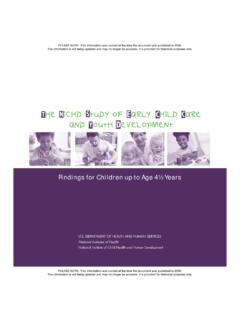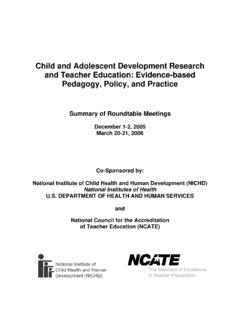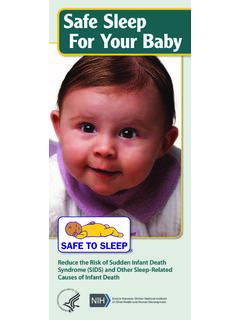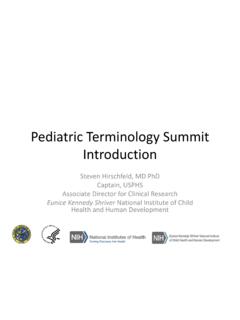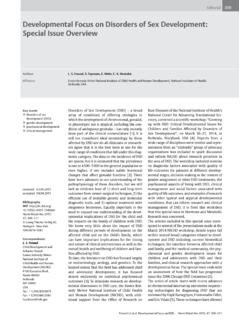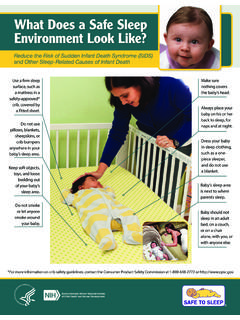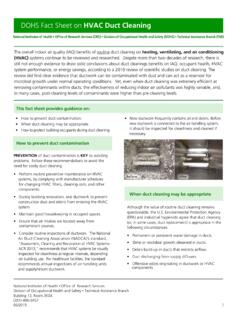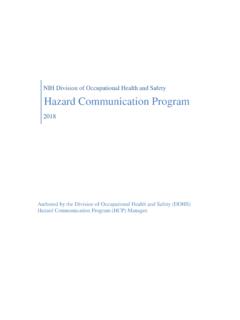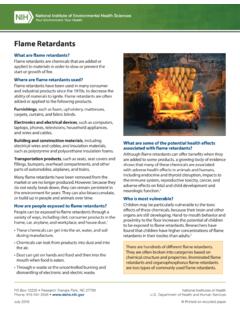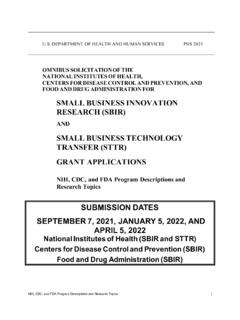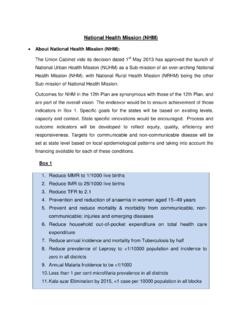Transcription of Infant Sleep Position SIDS - Eunice Kennedy Shriver ...
1 Infant Sleep Position andSIDS Questions and Answers for health Care DEPARTMENT OF health AND HUMAN SERVICESN atioNal iNstitutes of HealtHEunice Kennedy Shriver national institute of Child health and Human DevelopmentDear Colleague:As Director of the Eunice Kennedy Shriver national institute of Child health and Human Development (NICHD), I am pleased to provide this updated version of Infant Sleep Position and SIDS: Questions and Answers for health Care Providers. This booklet includes information and references that reflect the most recent recommendations from the American Academy of Pediatrics (AAP) Task Force on Sleep Position and Sudden Infant Death Syndrome (SIDS) and scientific research on reducing the risk of SIDS.
2 Since the NICHD and its partners launched the national Back to Sleep campaign in 1994, we have made tremendous progress in helping to reduce the incidence of SIDS. Since 1994, the overall SIDS rate in the United States has declined by more than 50 percent. This is an extraordinary accomplishment, but our job is far from the overall rate of SIDS has declined dramatically, African American communities and American Indian/Alaska Native communities continue to be at increased risk. We share a common commitment to safeguarding the health and well-being of our nation s children.
3 Together, we can continue to make a difference, so that our messages reach every parent, every grandparent, and every Infant caregiver in every community in the United States. Each of us has a responsibility to learn more about SIDS and to share what we learn with our families, friends, neighbors, and communities. As a health care provider, you are uniquely positioned to advance this important cause. I encourage you to read this booklet carefully and to discuss its contents with patients who care for infants younger than one year of for all you have done to educate families and caregivers about reducing the risk of SIDS.
4 Let us continue to work together to help all infants grow into healthy adults. Sincerely yours, Alan E. Guttmacher, Director, NICHD1 Healthy babies should be placed on their backs to 2005, the American Academy of Pediatrics (AAP) Task Force on Infant Sleep Position and SIDS (hereafter, the AAP Task Force) issued revised recommendations for reducing the risk of Among them was the recommendation that healthy babies be placed on their backs to Sleep as the main way to reduce SIDS risk. The AAP first published this recommendation in 1992,2 after many research reports showed that babies placed on their stomachs to Sleep were at greater risk of dying from SIDS.
5 The AAP confirmed its recommendation in 1994,3 in 2000,4 and most recently in Along with the AAP and other partners, the NICHD has maintained the Back to Sleep campaign since 1994. The institute has prepared the following answers to commonly asked questions to help educate health care providers about the latest findings of SIDS research and risk-reduction strategies. Please note that some answers are based on expert opinion because current evidence is not sufficient to provide definitive answers. 2 What advice should health care providers give to parents about the ways to reduce the risk of SIDS?
6 health care providers should encourage parents to do the following to reduce the risk of SIDS: Always place your baby on his or her back to Sleep for naps and at night. The back Sleep Position is the safest, and every Sleep time counts. Place your baby on a firm Sleep surface, such as a safety-approved crib mattress, covered by a fitted sheet.* Never place your baby to Sleep on pillows, quilts, sheepskins, and other soft surfaces. Keep soft objects, toys, and loose bedding out of your baby s Sleep area. Don t use pillows, blankets, quilts, sheepskins, or pillow-like crib bumpers in your baby s Sleep area, and keep all items away from your baby s Do not allow smoking around your baby.
7 Don t smoke before or after the birth of your baby, and don t let others smoke around your baby. Keep your baby s Sleep area close to, but separate from, where you and others Sleep . Your baby should not Sleep in a bed or on a couch or armchair with adults or other children, but he or she can Sleep in the same room as you. If you bring your baby into bed with you to breastfeed, put him or her back in a separate Sleep area, such as a bassinet, crib, cradle, or a bedside co-sleeper ( Infant bed that attaches to an adult bed) when finished.
8 Think about using a clean, dry pacifier when placing the Infant down to Sleep , but don t force the baby to take it. (If you are breastfeeding your baby, wait until your child is one month old or is used to breastfeeding before using a pacifier.) Do not let your baby get overheated during Sleep . Dress your baby in light Sleep clothing, and keep the room at a temperature that is comfortable for an adult. Avoid products that claim to reduce the risk of SIDS. Most of these products have not been tested for effectiveness or safety.
9 Do not use home monitors to reduce the risk of SIDS. If you have questions about using monitors for other conditions, talk to your health care provider. Reduce the chance that flat spots will develop on your baby s head. Provide tummy time when your baby is awake and someone is watching; change the direction that your baby lies in the crib from one week to the next; and avoid too much time in car seats, carriers, and bouncers.* For more information on crib safety guidelines, call the Consumer Product Safety Commission at 1 800 638 2772 or visit its Web site at Urge patients who do not have a crib to check with their state health department or local SIDS foundation about a crib donation Sleep Position is safest for full-term babies in hospital nurseries?
10 Healthy babies who are born full-term should be placed on their backs to Sleep in hospital nurseries. Research shows that mothers and caregivers use the same Sleep Position for their babies at home that they see being used at the ,6 Therefore, hospital nursery personnel should place babies on their backs to Sleep for naps and at night. If hospital personnel have concerns about possible choking for the first few hours following birth, they can place infants on their sides, propped up against the side of the bassinet for stability.
